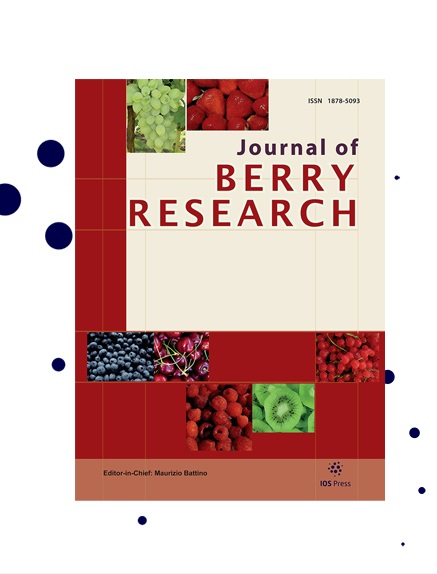Aqueous extract of andean berry induces apoptosis in human colon cancer cells without mitochondrial damage
IF 1.4
4区 农林科学
Q3 PLANT SCIENCES
引用次数: 4
Abstract
BACKGROUND: Andean berry contains several classes of phenolic compounds which have showed antioxidant and cytotoxic activity. OBJECTIVE: To characterize the Andean berry aqueous extract and to study their anti-proliferative mechanisms on SW480 and SW620 cell lines (human colon adenocarcinoma). METHODS: Total phenolic and total anthocyanins contents were determined by Folin-Ciocalteau and differential pH methods, respectively. Antioxidant activity was measured by FRAP, ORAC and DPPH methods. Antiproliferative effect was determined by sulforhodamine colorimetric method and apoptosis was analyzed by flow cytometry using propidium iodide/Annexin-V. Mitochondrial potential was evaluated using DIOC6 and ROS levels were measured by 2,7-Dicholorodihydrofluorescein diacetate (DCFH-DA). RESULTS: The total phenol and anthocyanin content were 4409.78± 63,05 mg equivalents of gallic acid/100 mL and 106,57± 1.43 mg equivalents of cyanidin-3-glycoside/100 mL, respectively. Andean berry extract showed antioxidant activity by FRAP, ORAC and DPPH methods and antiproliferative effect on SW480 and SW620 cells. It was observed a cell cycle arrest at S and G2/M phases on SW480 and at G0/G1 phase on SW620 cells. Aqueous extract did not induce mitochondrial depolarization or affect intracellular ROS levels. CONCLUSIONS: Andean berry aqueous extract has antioxidant capacity and induces apoptosis involving cell cycle arrest in SW480 and SW620 cells without mitochondrial damage.越橘水提取物诱导人结肠癌癌症细胞凋亡而无线粒体损伤
背景:安第斯浆果含有几种酚类化合物,具有抗氧化和细胞毒性活性。目的:研究安第斯浆果水提取物对人结肠癌细胞株SW480和SW620的抗增殖作用。方法:采用Folin-Ciocalteau法和差示pH法分别测定总酚含量和总花青素含量。采用FRAP法、ORAC法和DPPH法测定抗氧化活性。用磺基罗丹明比色法测定抗增殖作用,用碘化丙啶/膜联蛋白-V流式细胞术分析细胞凋亡。使用DIOC6评估线粒体电位,并通过2,7-二氯二氢荧光素二乙酸酯(DCFH-DA)测量ROS水平。结果:总酚和花青素含量为4409.78±63,05mg没食子酸当量/100 mL和106.57±1.43 mg当量氰化物-3-糖苷/100 mL。通过FRAP、ORAC和DPPH方法,安第斯浆果提取物显示出抗氧化活性,并对SW480和SW620细胞具有抗增殖作用。观察到SW480细胞在S期和G2/M期以及SW620细胞在G0/G1期的细胞周期停滞。水提取物不诱导线粒体去极化或影响细胞内ROS水平。结论:安第斯浆果水提取物具有抗氧化能力,在没有线粒体损伤的情况下诱导SW480和SW620细胞凋亡,涉及细胞周期停滞。
本文章由计算机程序翻译,如有差异,请以英文原文为准。
求助全文
约1分钟内获得全文
求助全文
来源期刊

Journal of Berry Research
Biochemistry, Genetics and Molecular Biology-Biochemistry
CiteScore
3.50
自引率
11.80%
发文量
21
期刊介绍:
The main objective of the Journal of Berry Research is to improve the knowledge about quality and production of berries to benefit health of the consumers and maintain profitable production using sustainable systems. The objective will be achieved by focusing on four main areas of research and development:
From genetics to variety evaluation
Nursery production systems and plant quality control
Plant physiology, biochemistry and molecular biology, as well as cultural management
Health for the consumer: components and factors affecting berries'' nutritional value
Specifically, the journal will cover berries (strawberry, raspberry, blackberry, blueberry, cranberry currants, etc.), as well as grapes and small soft fruit in general (e.g., kiwi fruit). It will publish research results covering all areas of plant breeding, including plant genetics, genomics, functional genomics, proteomics and metabolomics, plant physiology, plant pathology and plant development, as well as results dealing with the chemistry and biochemistry of bioactive compounds contained in such fruits and their possible role in human health. Contributions detailing possible pharmacological, medical or therapeutic use or dietary significance will be welcomed in addition to studies regarding biosafety issues of genetically modified plants.
 求助内容:
求助内容: 应助结果提醒方式:
应助结果提醒方式:


